Contents
The Pinova apple tree is a hybrid that is popular in many countries and has valuable characteristics. Ripe fruits have excellent taste and are suitable for home-made preparations for the winter.
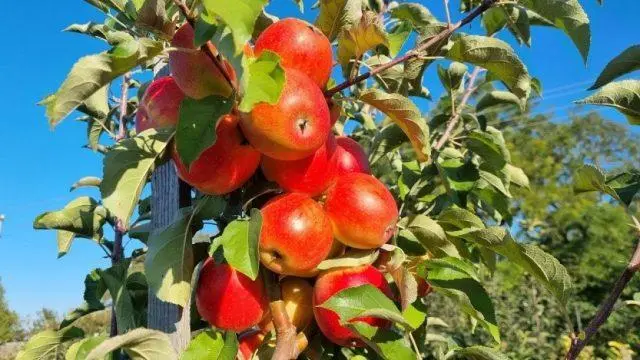
Pinova apple trees are high yielding
History of breeding
The Pinova apple variety is the result of many years of work by breeders from East Germany. The source material was Golden Delicious and Clivia apple trees, which have excellent commercial qualities. In 1986, the bred fruit crop was patented and in a few decades has become widespread throughout the world.
It has been registered in the state register of breeding crops in Our Country since 2016. The following is a detailed description and photo of the Pinova apple variety.
Description of the Pinova apple tree with a photo
The variety of fruit trees Pinova is suitable for cultivation in individual horticultural plots. It is also used for growing fruits on an industrial scale.
tree appearance
The Pinova apple tree is a medium-sized tree. The height of an adult plant is 3 – 3,5 m. The crown is cone-shaped, of an average degree of thickening. The branches are compact.
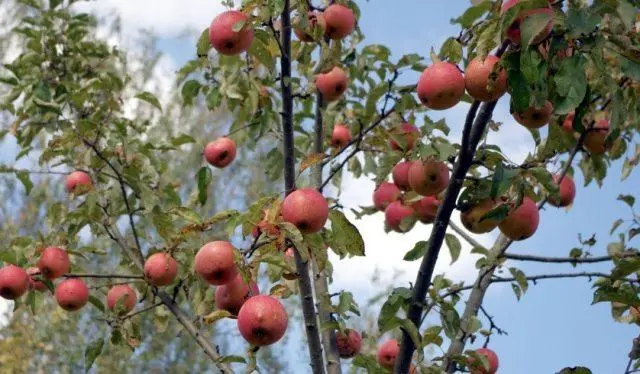
The branches of the tree are at right angles to the trunk.
The Pinova variety is also presented under other names. In some specialized reference books, the hybrid is referred to as Pinata, Coral and Sonata.
Description of fruits
The fruits of the Pinova apple tree are quite large. The average weight of an apple is 170-200 g. But some fruits grow larger and can weigh 300 g. Apples of this variety are slightly elongated, conical in shape, with barely visible ribbing.
Ripe fruits acquire a beautiful uniform matte red color. A dense blush in small areas is interrupted by a lighter shade with subcutaneous dots barely visible through the thin skin and blurry stripes.
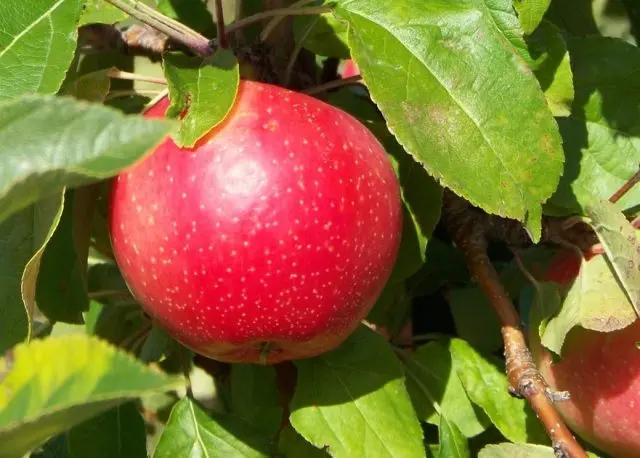
The fruits of the Pinova variety have a coral-red color.
Characteristics of the Pinov apple tree
The fruit tree has increased resistance to infectious diseases and frost resistance. The culture adapts well, showing resistance to heat and drought.
Palatability
Ripe fruits of the Pinova apple tree have a pleasant sweet and sour taste and a pronounced apple aroma. The flesh is creamy, juicy and firm.
Terms of maturation
Pinova apple trees are winter species. The flowering of the fruit crop begins at the end of April. The fruits reach their final maturity in September-October, depending on the geographical latitude.
Productivity
The apple tree bears fruit, as a rule, for 2-3 years after planting the seedlings. As the plant matures, the volume increases. Already in the sixth year, the tree is able to give a bountiful harvest – up to 40 kg of quality fruits per season.
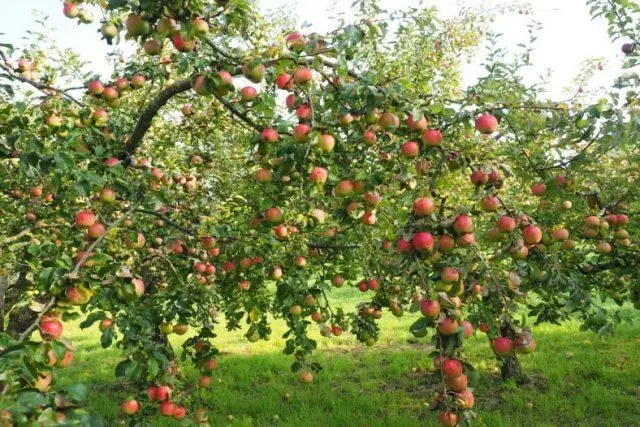
Annual pruning of lateral branches is the key to a bountiful harvest of apples
Frost resistance of the Pinova apple tree
The fruit tree has a high level of frost resistance. Temperature indicators that an apple tree can withstand without additional insulation are -24-25 0C.
Experts warn that the winter hardiness of the plant is significantly reduced when growing on waterlogged soils, especially in lowland areas. In the case of a snowless, frosty winter, it is recommended to mulch the tree trunks with a layer of peat or humus.
Pollinators
Pinova belongs to the category of self-fertile varieties. Due to the inability to achieve self-pollination of trees, other pollinators must be planted around the plantings.
Among mutually pollinated varieties, German breeders distinguish:
- Golden Delicious;
- Coke Orange;
- Fuji;
- Champion;
- Melrose;
- Elstar.
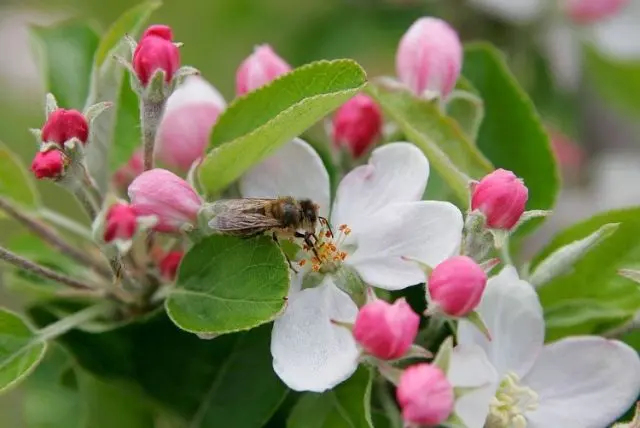
Full fruiting of Pinova variety trees is possible if mutually pollinated apple species are planted nearby
Growing regions
The area of growth of the Pinova variety is extensive. Apple trees have taken root on all continents except Antarctica, but the temperate and subtropical climatic zones are considered the best conditions for breeding.
In Our Country, Pinov’s apple trees feel great in the North Caucasus region. Adapted garden trees in the Middle lane, the Volga region and the Urals. But for the successful cultivation and preservation of young trees in the temperate climate zone, it is necessary to provide additional measures – shelter with matting or other protective materials.
Disease resistance
The Pinova apple variety has an increased resistance to infectious diseases and pests. Gardeners confirm that the tree is not susceptible to scab, which affects many types of fruit crops. Pinova has moderate resistance to fire blight and powdery mildew.
Advantages and disadvantages
Pinova apple trees, like any fruit crop, have their advantages and disadvantages. The undeniable advantages of this type are:
- excellent taste;
- precocity (for 2-3 years);
- annual big harvest;
- long shelf life of fruits;
- resistance to bacteria, fungi, parasites and exposure to cold.
The disadvantages of the variety are associated with the creation of additional conditions for growing crops. Gardeners consider the main disadvantages:
- the need to breed additional pollinators;
- the obligatory regular thinning of the ovaries.
How to plant
Experts recommend planting apple seedlings in early autumn so that they can take root before the onset of stable cold weather. For the development of the tree, nutritious soils with a good level of permeability to moisture and air (sandy, loamy), with no stagnant groundwater are necessary.
It is advisable to choose an open area illuminated by the sun during daylight hours. Best of all, one- and two-year-old seedlings adapt in a new place. When planting, a distance between trees of 3,5-4,5 m should be observed.
Compliance with the rules of agricultural technology allows you to achieve an excellent harvest. Features of care are similar in relation to other varieties of apple trees. When cultivating fruit trees in areas with a temperate climate, watering is carried out as needed. In a hot climate, the Pinova variety needs frequent irrigation, timely watering during the budding period is especially important.
Care instructions
Every spring, it is necessary to remove twigs and excess shoots affected by frost. The horticultural crop is responsive to top dressing, primarily with organic fertilizers.
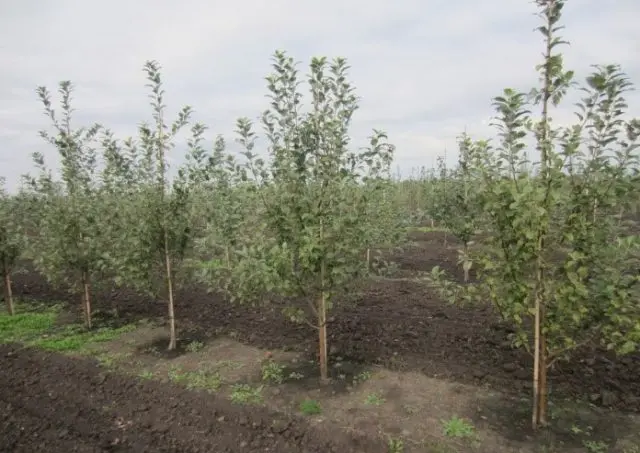
When planting, it is necessary to provide a space of 3,5 m between seedlings
Experienced gardeners are advised to adhere to the following algorithm:
- before flowering, a nitrogen-containing fertilizer is applied;
- at the end of flowering, mineral complexes containing phosphorus and potassium are used;
- mulch (compost, sawdust, humus, peat) is used throughout the season.
For better penetration of nutrients into the root system, several holes are formed around the tree. Fertilizer is poured into the dug recesses.
Collection and storage
Apples hold tightly and practically do not fall off when ripe. The fruits of the Pinov apple tree reach removable maturity in September, early October. It is necessary to harvest the crop carefully, since the pulp of the fruit is not dense enough. Apples should be stored in refrigeration units or cool basements. Optimum temperature +1 0C. For storage, the fruits are stacked in layers in boxes or containers with sawdust. Under specially created conditions, apples do not lose their commercial qualities for nine months.
Conclusion
Pinova apple trees are a promising hybrid that has become widespread in Europe and America. Proper care of the fruit crop allows you to get a big harvest with excellent taste.










